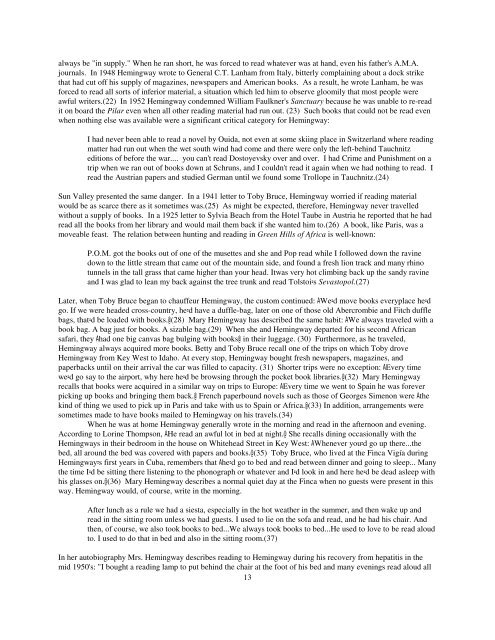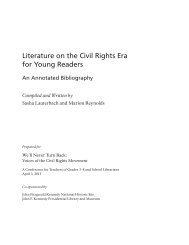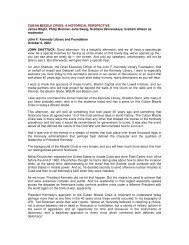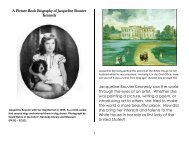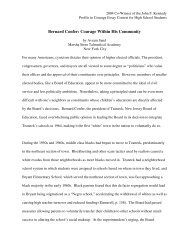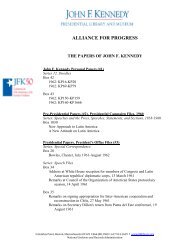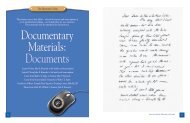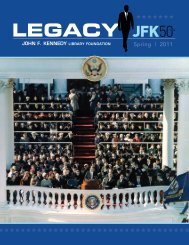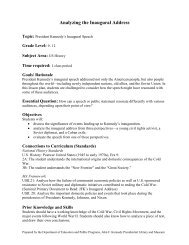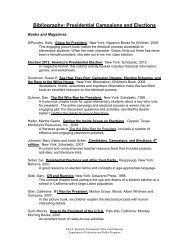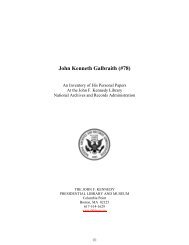1 hemingway's library - John F. Kennedy Library and Museum
1 hemingway's library - John F. Kennedy Library and Museum
1 hemingway's library - John F. Kennedy Library and Museum
You also want an ePaper? Increase the reach of your titles
YUMPU automatically turns print PDFs into web optimized ePapers that Google loves.
always be "in supply." When he ran short, he was forced to read whatever was at h<strong>and</strong>, even his father's A.M.A.<br />
journals. In 1948 Hemingway wrote to General C.T. Lanham from Italy, bitterly complaining about a dock strike<br />
that had cut off his supply of magazines, newspapers <strong>and</strong> American books. As a result, he wrote Lanham, he was<br />
forced to read all sorts of inferior material, a situation which led him to observe gloomily that most people were<br />
awful writers.(22) In 1952 Hemingway condemned William Faulkner's Sanctuary because he was unable to re-read<br />
it on board the Pilar even when all other reading material had run out. (23) Such books that could not be read even<br />
when nothing else was available were a significant critical category for Hemingway:<br />
I had never been able to read a novel by Ouida, not even at some skiing place in Switzerl<strong>and</strong> where reading<br />
matter had run out when the wet south wind had come <strong>and</strong> there were only the left-behind Tauchnitz<br />
editions of before the war.... you can't read Dostoyevsky over <strong>and</strong> over. I had Crime <strong>and</strong> Punishment on a<br />
trip when we ran out of books down at Schruns, <strong>and</strong> I couldn't read it again when we had nothing to read. I<br />
read the Austrian papers <strong>and</strong> studied German until we found some Trollope in Tauchnitz.(24)<br />
Sun Valley presented the same danger. In a 1941 letter to Toby Bruce, Hemingway worried if reading material<br />
would be as scarce there as it sometimes was.(25) As might be expected, therefore, Hemingway never travelled<br />
without a supply of books. In a 1925 letter to Sylvia Beach from the Hotel Taube in Austria he reported that he had<br />
read all the books from her <strong>library</strong> <strong>and</strong> would mail them back if she wanted him to.(26) A book, like Paris, was a<br />
moveable feast. The relation between hunting <strong>and</strong> reading in Green Hills of Africa is well-known:<br />
P.O.M. got the books out of one of the musettes <strong>and</strong> she <strong>and</strong> Pop read while I followed down the ravine<br />
down to the little stream that came out of the mountain side, <strong>and</strong> found a fresh lion track <strong>and</strong> many rhino<br />
tunnels in the tall grass that came higher than your head. Itwas very hot climbing back up the s<strong>and</strong>y ravine<br />
<strong>and</strong> I was glad to lean my back against the tree trunk <strong>and</strong> read Tolstoi=s Sevastopol.(27)<br />
Later, when Toby Bruce began to chauffeur Hemingway, the custom continued: AWe=d move books everyplace he=d<br />
go. If we were headed cross-country, he=d have a duffle-bag, later on one of those old Abercrombie <strong>and</strong> Fitch duffle<br />
bags, that=d be loaded with books.@(28) Mary Hemingway has described the same habit: AWe always traveled with a<br />
book bag. A bag just for books. A sizable bag.(29) When she <strong>and</strong> Hemingway departed for his second African<br />
safari, they Ahad one big canvas bag bulging with books@ in their luggage. (30) Furthermore, as he traveled,<br />
Hemingway always acquired more books. Betty <strong>and</strong> Toby Bruce recall one of the trips on which Toby drove<br />
Hemingway from Key West to Idaho. At every stop, Hemingway bought fresh newspapers, magazines, <strong>and</strong><br />
paperbacks until on their arrival the car was filled to capacity. (31) Shorter trips were no exception: AEvery time<br />
we=d go say to the airport, why here he=d be browsing through the pocket book libraries.@(32) Mary Hemingway<br />
recalls that books were acquired in a similar way on trips to Europe: AEvery time we went to Spain he was forever<br />
picking up books <strong>and</strong> bringing them back.@ French paperbound novels such as those of Georges Simenon were Athe<br />
kind of thing we used to pick up in Paris <strong>and</strong> take with us to Spain or Africa.@(33) In addition, arrangements were<br />
sometimes made to have books mailed to Hemingway on his travels.(34)<br />
When he was at home Hemingway generally wrote in the morning <strong>and</strong> read in the afternoon <strong>and</strong> evening.<br />
According to Lorine Thompson, AHe read an awful lot in bed at night.@ She recalls dining occasionally with the<br />
Hemingways in their bedroom in the house on Whitehead Street in Key West: AWhenever you=d go up there...the<br />
bed, all around the bed was covered with papers <strong>and</strong> books.@(35) Toby Bruce, who lived at the Finca Vigía during<br />
Hemingway=s first years in Cuba, remembers that Ahe=d go to bed <strong>and</strong> read between dinner <strong>and</strong> going to sleep... Many<br />
the time I=d be sitting there listening to the phonograph or whatever <strong>and</strong> I=d look in <strong>and</strong> here he=d be dead asleep with<br />
his glasses on.@(36) Mary Hemingway describes a normal quiet day at the Finca when no guests were present in this<br />
way. Hemingway would, of course, write in the morning.<br />
After lunch as a rule we had a siesta, especially in the hot weather in the summer, <strong>and</strong> then wake up <strong>and</strong><br />
read in the sitting room unless we had guests. I used to lie on the sofa <strong>and</strong> read, <strong>and</strong> he had his chair. And<br />
then, of course, we also took books to bed...We always took books to bed...He used to love to be read aloud<br />
to. I used to do that in bed <strong>and</strong> also in the sitting room.(37)<br />
In her autobiography Mrs. Hemingway describes reading to Hemingway during his recovery from hepatitis in the<br />
mid 1950's: "I bought a reading lamp to put behind the chair at the foot of his bed <strong>and</strong> many evenings read aloud all<br />
13


